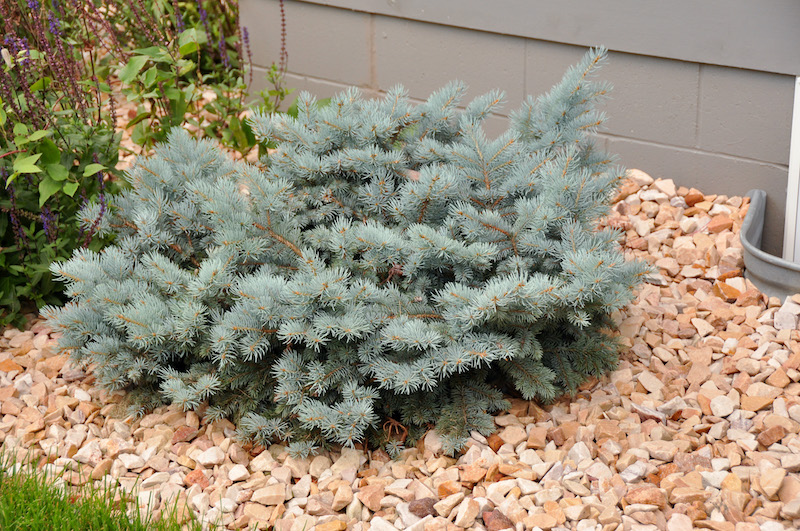Growing Spruce
Spruce belongs to the genus Picea, a group of large coniferous trees distributed around temperate regions in the Northern Hemisphere and grown in Hardiness Zones 2-8. Spruce trees can be distinguished by their four-sided needles and downward-hanging cones once they mature. Spruce varieties have many colors, habits and shapes. They are useful in providing a noise and wind barrier to your property, and they are an important home for wildlife.

Planting Spruce
Plant Spruce trees in well-draining, fertile, loamy soil, rich in organic content such as garden compost. It's important to conduct a soil drainage test to ensure the hole isn’t holding onto too much water, which can lead to tree failure. The location should have plenty of sun, at least 6-8 hours of direct sunlight daily. Depending on the variety of Spruce, be sure your location has plenty of room for the tree to grow to its full mature size.

Dig a hole the same depth as the root system, but twice as wide. Chop the sides of the hole to loosen any compacted soil. Remove the Spruce from its container, and gently loosen the roots, particularly if you notice them circling. If the Spruce is heavily root bound, take a sharp disinfected knife and make a few cuts vertically, along the root mass. Place the Spruce into the hole, backfill with existing soil, and pack the site down firmly to ensure there are no air pockets. Water deeply and thoroughly, around the entire root system. Apply a couple of layers of natural mulch around the base of the root system to suppress weeds and conserve moisture; be sure to pull the mulch away from the trunk.
Watering Spruce
After planting a new Spruce sapling or young tree, water it deeply every few days, making sure the water is reaching the root zone. Increase the watering frequency during the driest and hottest months of summer, checking the soil moisture often. Once the roots are getting established after the first growing season, you can water less frequently.
Fertilizing Spruce
If your Spruce has healthy growth and color, there is no need to add extra fertilization. If you notice new growth is sparse or the needles are discolored, your Spruce may need supplemental nutrition. It's important to do a soil test before planting your Spruce, as most evergreens enjoy a slightly acidic soil pH.
If fertilization becomes necessary, apply the feed in early spring, before new growth emerges. Use a formula specific to evergreens, and always follow package instructions and water the soil before applying fertilizer.
Pruning Spruce
It's only necessary to prune Spruce if you notice any damaged, crossing, dead or diseased branches. Use sterilized pruners, loppers, or a handsaw and make cuts an inch or so away from the trunk to avoid leaving a wound where insects or disease could enter the trunk. Make a clean cut, and never rip or tear the tree bark. Do not compost diseased branches to avoid spreading pathogens.

Caring For Spruce in Pots
Depending on the variety, some dwarf Spruce trees grow well in large containers. They don’t like to be transplanted once settled, so select a container that can accommodate the growing rootball for years to come. Spruces must have well-draining soil, and the container should have plenty of drainage holes to drain water away from the root system.
Spruces require lots of sun to grow healthy, so place the container in an area where it will receive at least 6 hours of direct sunlight per day. Newly planted Spruces may need more frequent water during its first growing season, particularly during a drought in the hottest months of summer. Check the first few inches of the soil, and if they feel dry, water deeply. Fertilize using a product that is specifically formulated for evergreens, and follow the instructions on the package.
Winter Care for Spruce
Most spruce varieties are cold and frost hardy, but protecting a newly planted young Spruce may be necessary, particularly if it is planted in an open, high-wind area or close to a street exposed to salt spray. Water Spruce deeply before the first frost, and then apply a few inches of natural mulch around the plant's root zone to help insulate it. If your Spruce is exposed to excessive cold or wind, you can wrap it in burlap to protect it from wind burn.
 |
Author Chris Link - Published 03-16-2023 |
